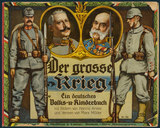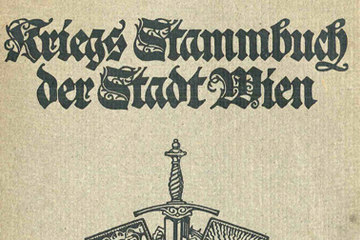-

Hanns Anker: Cover of the book “Der große Krieg. Ein deutsches Volks- und Kinderbuch”, 1917
Copyright: Schloß Schönbrunn Kultur-und Betriebsges.m.b.H./Fotograf: Alexander E. Koller
Partner: Schloß Schönbrunn Kultur- und Betriebsges.m.b.H. -

Viktor Halmi: Gala presentation in the Court Opera House in honour of the German Kaiser Wilhelm II, drawing, 1908
Copyright: Schloß Schönbrunn Kultur-und Betriebsges.m.b.H./Fotograf: Alexander E. Koller
As in the Habsburg Empire, the political system of the German Empire was shaped by the strong role of the monarchy.
The German imperial dynasty of the Hohenzollerns had its roots in the Kingdom of Prussia. Thus Emperor Wilhelm I (1797–1888), although the first emperor of a united Germany since 1871, saw himself first and foremost as Prussian monarch. Venerated as a father figure, he died in 1888 at the ripe old age of 91. His son and successor Friedrich Wilhelm (1831–1888) was hailed already as crown prince as a new-generation hope for liberal sensibilities, but was gravely ill. Suffering from laryngeal cancer and the resulting loss of voice, he died after only 99 days as regent. His son Wilhelm (1859-1941) was the exact opposite of his father: clearly positioned as extremely conservative, Wilhelm II came to power in June 1888 at the age of 29.
The two ruler personalities, Franz Joseph and Wilhelm II were separated by conspicuous differences in age: Wilhelm belonged to a younger generation; he was almost the same age as Franz Joseph’s son Crown Prince Rudolf, with whom Wilhelm was often compared. The friendship between the two princes was much propagandised, purporting to reflect the political rapprochement between the two empires. But in truth their relationship was characterised by glaring differences of opinion and chilly feelings of rivalry, which was to escalate dramatically when Wilhelm came to power in 1888, while Rudolf had persevere in his waiting position.
Wilhelm had an extremely reactionary understanding of monarchic rule, while Rudolf was an advocate of liberal ideas. The Hohenzollern prince was the epitome of Prussiandom: militarist and snappish, pompous and German-nationalistic with an obtrusively chauvinist vein, he acted out of a position of bullying strength. Wilhelm’s arrogance reflected the self-assurance of Germany as the new foremost power in Central Europe; this was seen by the Habsburg Monarchy as a threat, its self-image shattered after the painful defeat in the process of German Unification. Vienna reacted with a mixture of adulation and stubborn insistence on the venerable traditions of Habsburg rule. Particularly German-nationalist circles saw their “true” ruler in Wilhelm, and when the new German emperor visited Austria in October 1888 to celebrate his accession, the Austrian authorities had their work cut out for them to curb the ovations so as to avoid embarrassing scenes for Franz Joseph.
Wilhelm’s relationship to Archduke Franz Ferdinand was distinctly better: the two men were closer in ideology and occasionally developed a real sympathy for each other, mostly thanks to Wilhelm’s gentlemanly behaviour to the wife of the Austrian successor to the throne, who was not of the social rank regarded as befitting to marry a member of the Imperial House. When the German Kaiser was the first monarch to invite Sophie expressly to a state visit – until then she had never made an official appearance – the ice was broken, and Franz Ferdinand felt obliged to feel grateful towards Wilhelm, despite certain political differences.
Wilhelm’s personality was not least shaped by his physical disability; because of his difficult birth his left arm was paralysed. Biographers see in this the reason for a disturbed feeling of self-worth, which he wished to compensate through a mania for manliness and glorification of the military.
His thirty years of rule are known as the “Wilhelminian Epoch” and were characterised by a reinforcement of Germany’s position as a great power, a forced development of the colonies and a dynamic boom in economy and industry. The shadow side is manifest in massive rearmament and an aggressive foreign policy, also militarism that penetrated the whole of society. Wilhelm made no secret of his hostility to France and was also felt personal animosity against Great Britain, although the English Court traditionally counted among the friendly powers – also on account of multiple family ties (Wilhelm’s mother was a daughter of Queen Victoria).
His relationship to Austria-Hungary, Germany’s closest ally based on the Dual Alliance of 1879, was burdened by his lack of understanding for the difficult problems of the heterogeneous multi-ethnic State. Wilhelm did not mince his words when judging the situation in the dual monarchy. The German Kaiser openly criticised the military and political weakness of his ally and believed in general he had diagnosed its malady in the “sloppiness typical of the country.”
Wilhelm’s role at the outbreak of the First World War was ambivalent. In his bellicose world view he saw the final decisive battle dawning between the Germanic people and the Slavs. On the other hand, he initiated attempts to prevent the war against Russia by appealing to dynastic solidarity between the monarchs. But in the end he affirmed his unlimited support for Austrian military policy against Serbia and thus paved the way for a warlike escalation.
As the war continued, the Kaiser, who despite his enthusiasm for everything military availed only a of a mediocre strategic talent, was manoeuvred into the background in comparison with the Supreme Military Command of the German Army, which gradually claimed a well-nigh dictatorial prerogative of power. Nevertheless, on the outside Wilhelm remained the defining symbolic figure and was far more active in making public appearances than Franz Joseph. Because of the power vacuum left by the ancient Habsburg’s non-presence, the German Kaiser assumed the role of the leading ruler personality in the camp of the Central Powers – a constellation in which later the young Emperor Karl would not offer any serious competition.
Forced to abdicate on 9 November 1918, Wilhelm II went into exile in the Netherlands, where he died in 1941.
Translation: Abigail Prohaska
Bled, Jean-Paul: Franz Ferdinand. Der eigensinnige Thronfolger, Wien u. a. 2013
Clark, Christopher M.: Wilhelm II. Die Herrschaft des letzten deutschen Kaisers, München 2008
Leidinger, Hannes/Moritz, Verena/Schippler, Bernd: Schwarzbuch der Habsburger. Die unrühmliche Geschichte eines Herrscherhauses (2. Auflage, ungekürzte Taschenbuchausgabe), Innsbruck [u.a.] 2010
Röhl, John C. G.: Wilhelm II., München 2013
-
Chapters
- Franz Joseph: the ageing emperor
- The problem of the succession
- Franz Joseph and Franz Ferdinand – a tense relationship
- Franz Ferdinand and his political programme
- Kaiser Wilhelm II: The Beloved Enemy
- “Archduke Bumbsti”
- Karl as successor to the throne
- The New Emperor
- Karl I and the collapse of the Monarchy
- The last days of the Monarchy
- Emperor Karl on his way into exile






